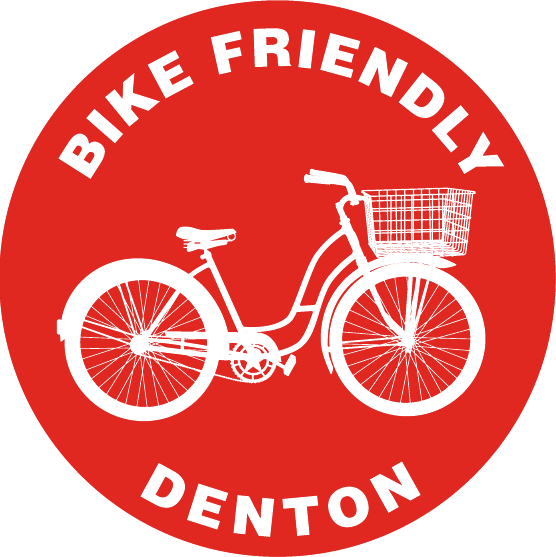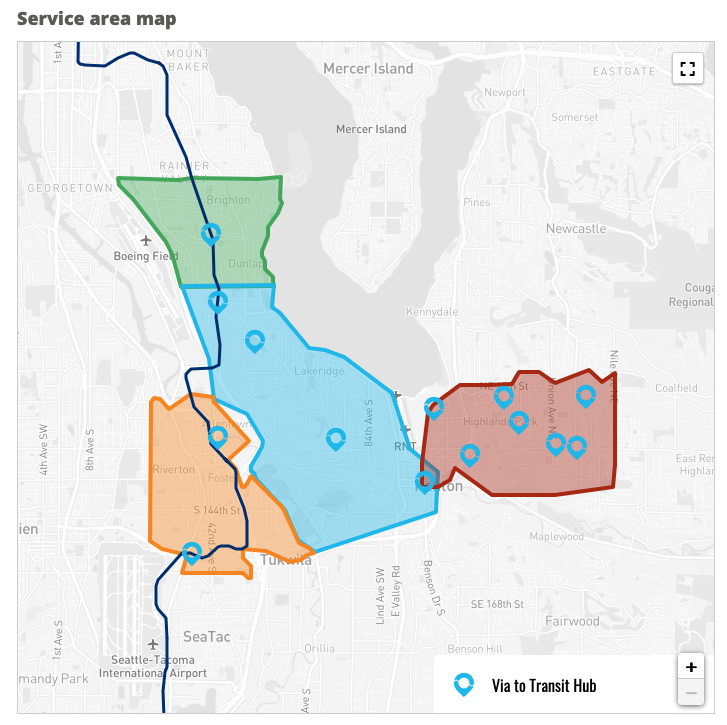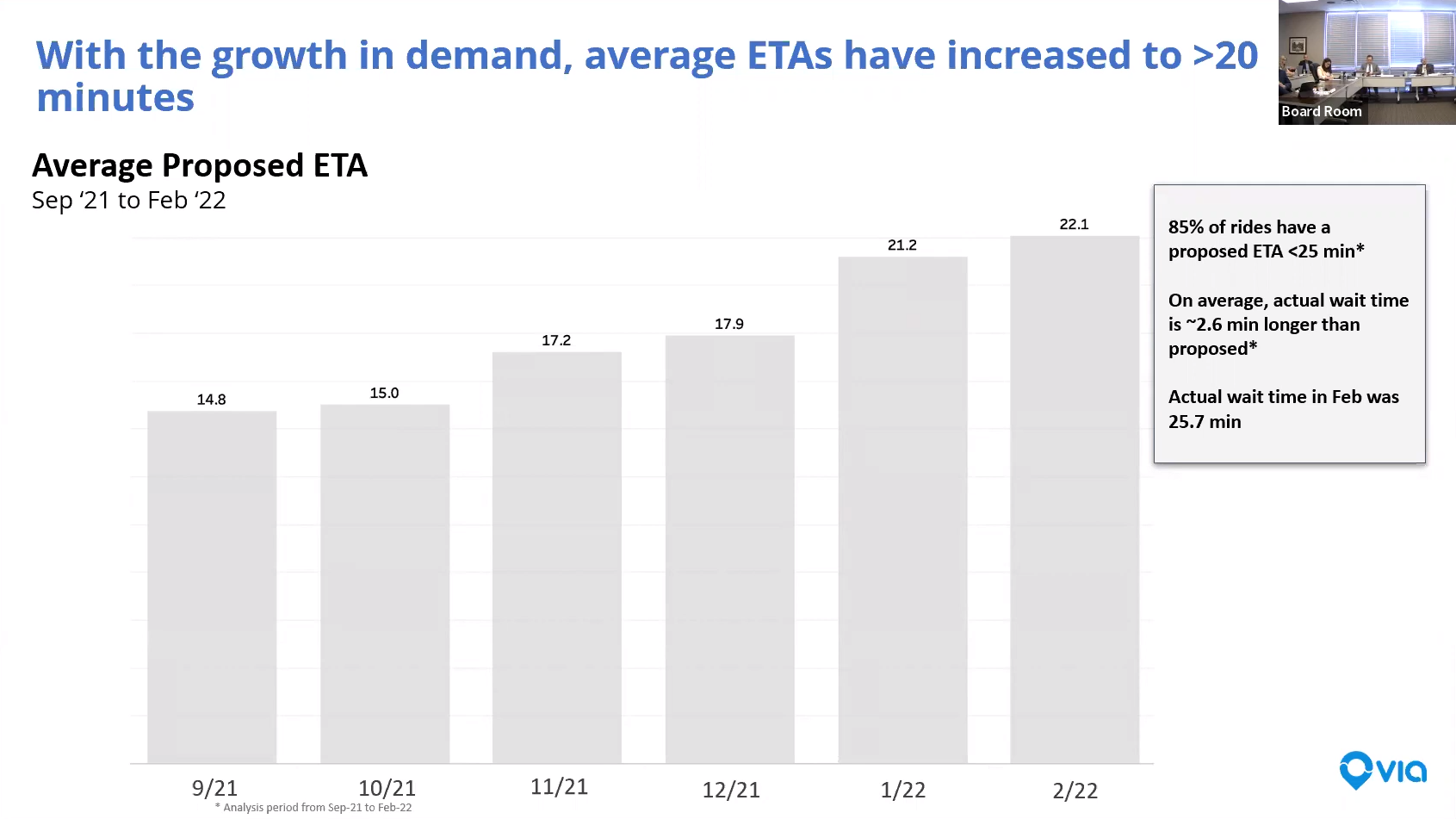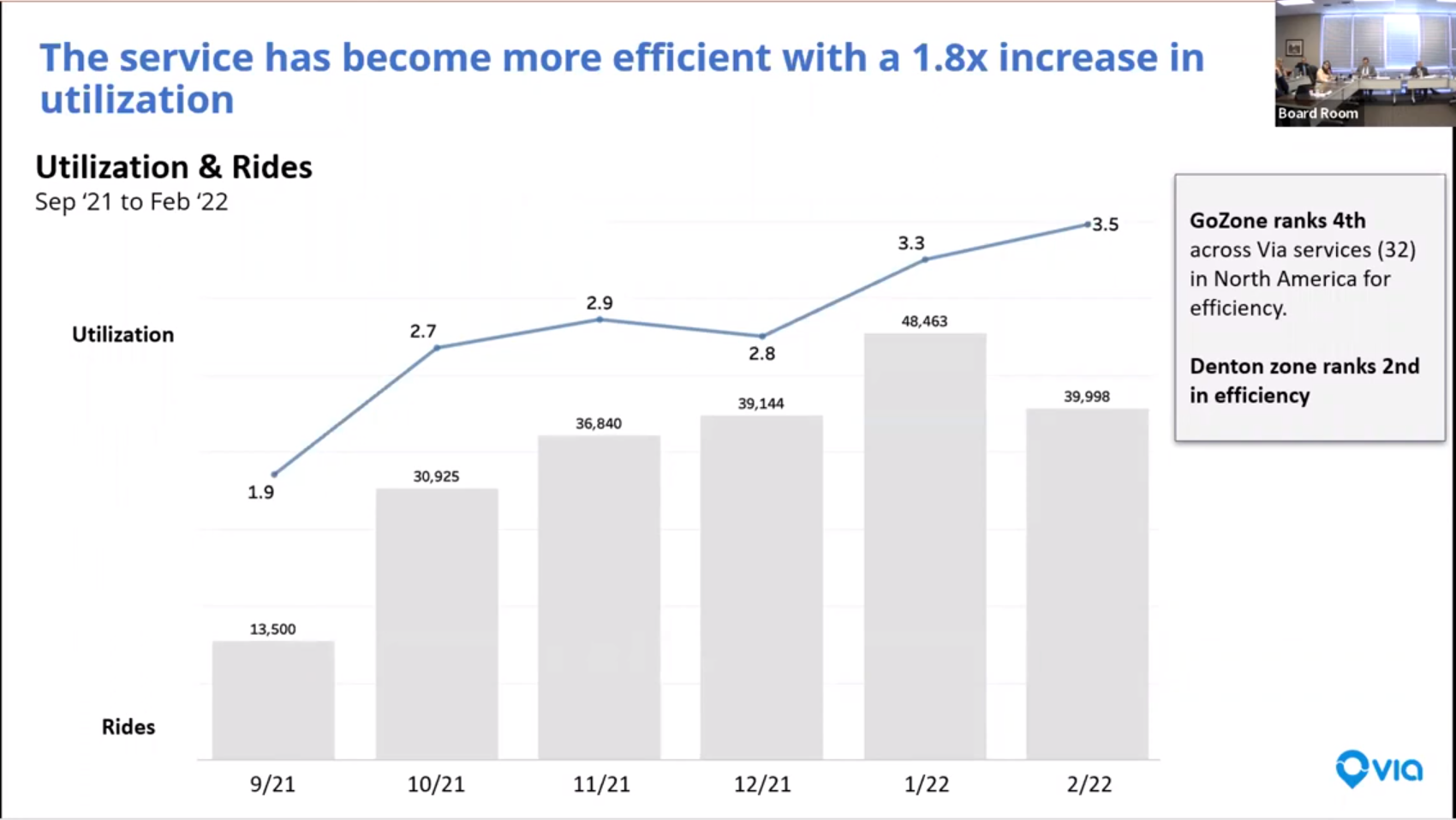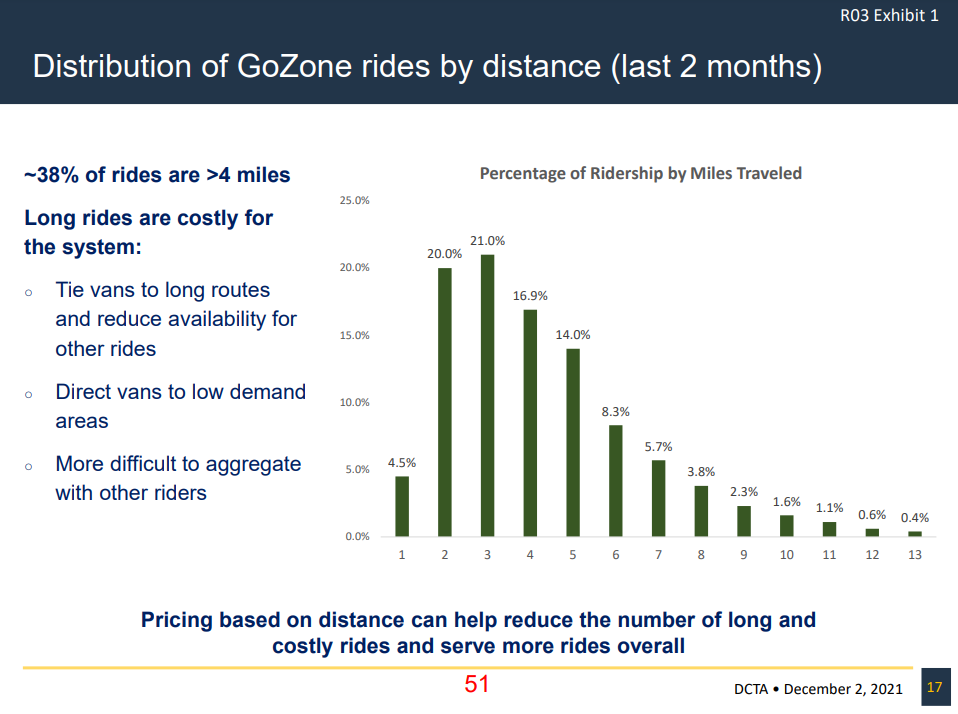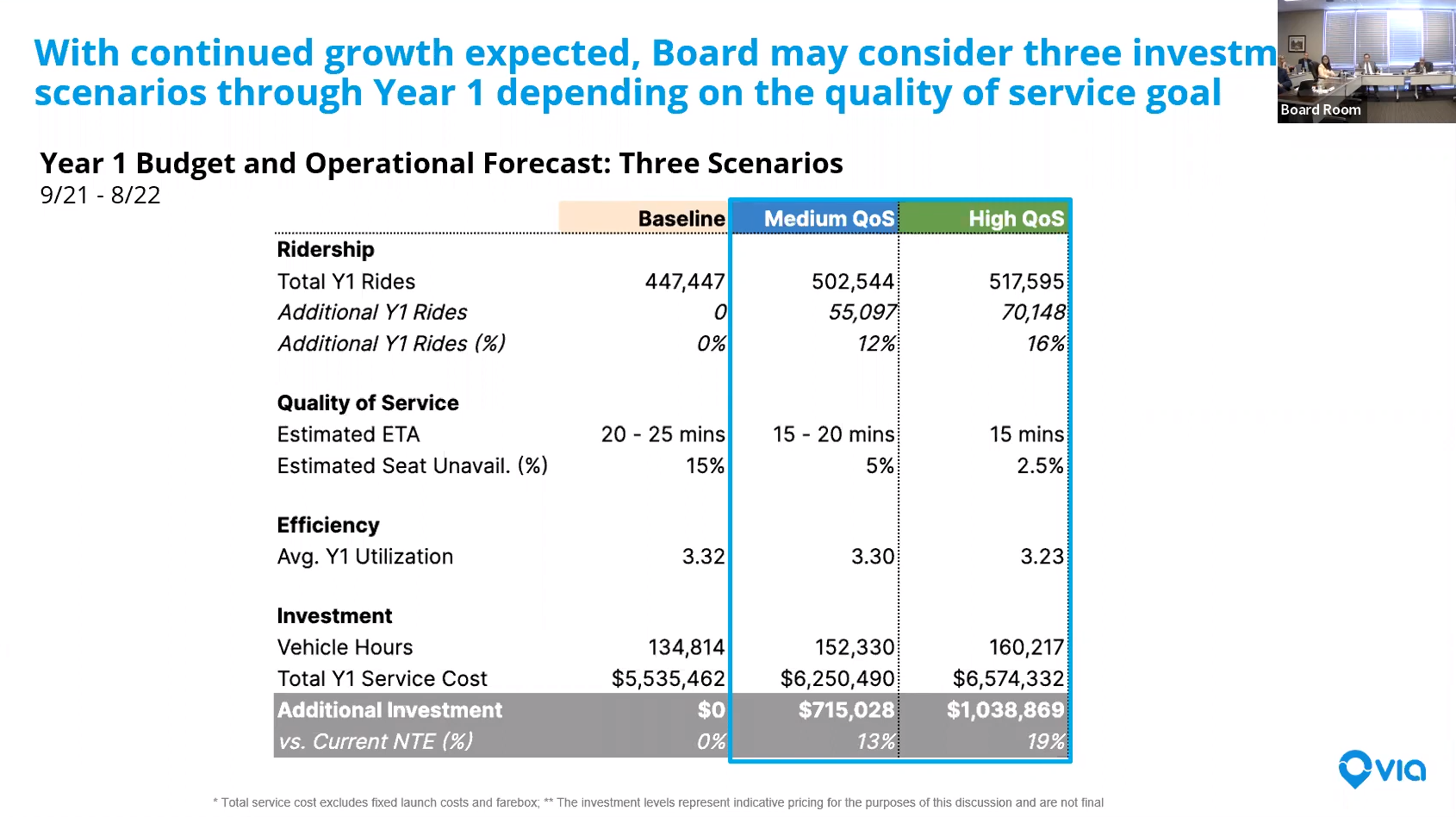DCTA Seeks Public Input on Fares and Services
April 28, 2022
GoZone vans at MedPark Station, September 2021.
The Denton County Transit Authority (DCTA) is evaluating changes to fixed bus routes, GoZone service and pricing structures, according to a DCTA press release from April 18. Public input will be gathered April 18 - June 10.
Virtual meetings can be accessed from dctafeedback.net and are scheduled for:
Monday, April 25 at 9 a.m.
Friday, April 29 at 12 p.m.
Thursday, May 5 at 6 p.m.
Tuesday, May 10 at 3:30 p.m.
One in-person meeting is scheduled for Wednesday, May 11 at 6 p.m. at the Downtown Denton Transit Center.
DCTA’s Public Involvement Plan promises public engagement in decision making processes including potential fare increases. DCTA’s on-demand microtransit service, GoZone, has been operating with a six-month promotional fare of 75 cents that was supposed to end in March. During the same period, the fare for fixed bus routes was $1.50 for an AM or PM pass.
The DCTA Board is now discussing the permanent pricing to use GoZone.
How much do other cities charge for similar services?
The City of Arlington, which began offering on-demand microtransit in 2017, charges $3-$5 per ride depending on distance. The City of Arlington and DCTA both use the company Via to power their microtransit service. Grand Prairie, Texas will charge $3-$4 per trip during their pilot project with Via, which began on April 12, 2022.
King County in Washington State charges $2.75 per trip, the same as their bus fare, to use Via. However, unlike Arlington or Grand Prairie, King County uses Via primarily to connect passengers to their bus and rail network through transit hubs. Riders are limited to small service zones when using Via and cannot use it to travel across multiple zones in a single trip.
Via service zones in King County, Washington (Source: King County Metro)
Managing ridership demand for GoZone
Ridership demand has spiked for DCTA’s GoZone since its launch in September 2021. With the increased demand has come increased service challenges and wait times.
In February 2022, 11 percent of potential passengers, about 8,000 people, were turned away due to lack of available seats.
Percentage of cases when no seats were available for a potential GoZone passenger (DCTA Board meeting on March 24, 2022)
For people who are able to book a ride, average wait times have increased well beyond Via’s original estimate of 10-15 minutes. In February 2022, the average actual wait time for passengers was 25.7 minutes. These wait times do not include the amount of time passengers spent waiting for a seat to become available so they could book a ride.
Average estimated wait times for GoZone, September 2021 through February 2022 (DCTA Board meeting on March 24, 2022)
A typical on-demand vehicle like GoZone carries an average of 2.4 to 4.7 passengers per vehicle service hour, leaving little capacity to accommodate increased demand.
In a presentation to the DCTA Board on March 24, 2022, Via shared that GoZone carried 2.7 to 3.5 passengers per vehicle service hour between October 2021 and February 2022.
Number of riders served per vehicle service hour, September 2021 through February 2022 (DCTA Board meeting on March 24, 2022)
Initial analysis suggested that GoZone would serve an average of 3.8 passengers per vehicle service hour compared to an average of 17 passengers per vehicle service hour across DCTA’s bus system in 2019 (Source: DCTA Board meeting agenda packet for March 28, 2022, p. 235).
Lengthy trips are one factor that has reduced GoZone’s efficiency. In October and November last year, DCTA found that approximately 34 percent of all GoZone trips were longer than four miles. Longer trips make the system less efficient by reducing availability for other riders and directing the vans to lower-demand areas.
One option to reduce the number of long rides is distance-based fare pricing, such as a base price of $1.50 plus an additional 50 cents per mile.
Slide from the DCTA Board agenda packet on December 2, 2021.
While longer GoZone trips have contributed to long, unpredictable wait times for passengers, another major factor is that ridership demand in general has outstripped the supply of vehicles and drivers. Via originally estimated that a fleet of 30-35 GoZone vehicles could accommodate 35,833 passengers each month with an average wait time of 10-15 minutes.
In October, one month after GoZone’s launch, riders began experiencing longer wait times and difficulty scheduling rides when ridership hit 30,925 for the month. DCTA responded by allocating more funding to add capacity with more vehicles and drivers.
Since October, ridership has consistently exceeded the roughly 36,000 monthly trips originally estimated, surpassing 48,000 passenger trips in January 2022. Ridership demand continues to outstrip vehicle and driver supply, resulting in increased seat unavailability and wait times.
GoZone ridership September 2021 through February 2022 (DCTA Board meeting on March 24, 2022)
To lower average wait times from the current 20-25 minutes down to 15 minutes, DCTA would need to spend an additional $1 million on top of the $5.5 million already budgeted for GoZone.
Anticipated cost to lower GoZone wait time to 15-20 minute and 15 minutes (DCTA Board meeting on March 24, 2022)
If GoZone is the top priority of the DCTA Board, keeping wait times down by continually increasing funding for more GoZone vehicles and drivers would eventually require a reduction in funding for other services like buses and the A-Train, resulting in fewer routes or lower bus or train frequency.
In 2019, DCTA spent $33.1 million on operating expenses. It allocated $13.8 million in operating expenses to bus service which served 2.36 million passenger trips and $14.1 million to A-Train service which served 221,316 passenger trips. The remaining $3.8 million in operating expenses were allocated to demand response and vanpool services which served a combined 189,752 passenger trips.
If maintaining or improving current bus and A-Train service is the top priority, DCTA cannot afford to continually increase GoZone capacity by funding more vehicles and drivers. Instead, it can increase GoZone capacity by reducing ridership demand through higher fares or through reduced service quality or availability.
DCTA is currently considering the following fare options for GoZone:
Flat Fare regardless of distance.
Distance-Based Fare that costs more for longer trips.
Hybrid Fare Model that combines the first two options and encourages riders to take the most efficient trip, like using GoZone to connect to a bus or the A-Train.
During the public input period between April 18 - June 10, members of the public may add their thoughts on a map, ideas wall or a general survey at DCTAFeedback.net.
Further Reading
Improving GoZone wait times could cost upward of $1 million, says contractor (Denton Record Chronicle, 3/24/2022)
GoZone’s 75-cent rides to stay put as DCTA launches bus route changes (Denton Record Chronicle, 3/8/2022)
DCTA reports GoZone demand is still increasing – and wait times with it (Denton Record Chronicle, 1/27/2022)
DCTA CEO weighs in on bus-GoZone hybrid model, driver safety (Denton Record Chronicle, 12/19/2021)
DCTA grapples with GoZone capacity as clock ticks on bus routes (Denton Record Chronicle, 10/28/2021)
DCTA Board moves toward replacing most fixed bus routes with on-demand vans (Bike Denton, 6/22/2021)
